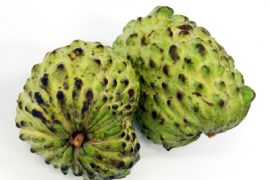Graviola and Cancer
The National Cancer Institute first noted the anticancer activity of graviola leaves in 1976, in an internal study not publicly released. Much of the subsequent research has been conducted at Purdue University in Indiana [source: Bluestein].
The studies concentrate on the antitumor properties and selective toxicity of annonaceous acetogenins. In 1997, the Purdue team announced that these phytochemicals, in studies, appeared especially effective at destroying cells that had survived chemotherapy. Such cells can develop resistance to several anti-cancer agents, earning the name multi-drug resistant (MDR). Typically, less than two percent of cancer cells have MDR properties, but this small set can quickly multiply after initial chemotherapy, rendering subsequent rounds of chemo useless. Expelling the anti-cancer agents requires large amounts of cellular energy, which MDR cells acquire from the chemical ATP. Acetogenins inhibit ATP transfer into these cells, retarding their function in a process that eventually leads to cell death. This process bypasses the healthy cells, which do not require infusions of ATP [source: Taylor].
These research findings have generated tremendous excitement, as well as an effort to market graviola supplements. Skeptical analysts point out that test-tube experiments are only a preliminary stage in cancer research, and it is therefore premature to ascribe a potent anticancer effect to graviola. Nevertheless, one study claimed that graviola was 10,000 times more effective against cancer than the well-known chemotherapy drug Adriamycin, and this dubious assertion has found its way to numerous promotional sites [source: graviola.org]. Ralph Moss, a respected cancer writer who has been critical of mainstream oncology, comments that “astounding claims concerning cancer cures spread like a virus from Web site to Web site.” However, Moss admits that graviola is “of potential importance to the future of medicine” [source: Moss]. Its increasing popularity indicates that some individuals are not content to wait for the blessing of the scientific establishment.Scientists prove the cancer-healing abilities of graviola in the lab and in living tissue
Oncologists agree that pancreatic cancer is one of the most difficult types of cancer to treat, and that being diagnosed with cancer of the pancreas is as good as a death sentence. The new study, performed by a cancer research team at the Department of Biochemistry and Molecular Biology at the University of Nebraska Medical Center, shows that graviola kills pancreatic cancer cells by inhibiting cellular metabolism. This cancer tumor-fighting ability has been confirmed both in test tubes and in live subjects.
Graviola works by inhibiting numerous signaling pathways that manage how pancreatic cancer cells grow, how long they live, and how the cancer tumors spread within the host. By altering these parameters, the rate of new cancer cell growth and spread of the disease slowed significantly.
The team of researchers considers the characteristics possessed by graviola “promising.”
Learn more: naturalnews.comConsiderations
Graviola exhibits anti-cancer activity in tissue culture and in some animal studies. Its promotion as an anti-cancer agent is based on these limited investigations and on traditional uses. However, graviola has not been adequately studied in humans. Despite widespread marketing of graviola products for cancer treatment and prevention, there is insufficient data to support its effectiveness or to ensure its safety. Consult a medical professional before you add graviola to your daily regimen.
Want to learn more read the original article here
Source: howstuffworks.com
What You Need to Know About Graviola – (Natural Cancer Fighter)



